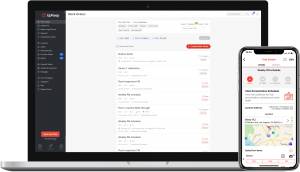What is the difference between EAM and CMMS?
At an essential level, enterprise asset management (EAM) software operates like a more advanced, larger-scale computerized maintenance management system (CMMS). To understand this a little better, let's break each of these types of software down to parts.

What is a CMMS?
This might be easiest to understand if we first look at what CMMS software can do. While each individual CMMS sports different features, at a baseline CMMS software records and categorizes data on maintenance tasks performed on a facility's assets. Basically, a facility's CMMS is like a massive computerized maintenance log - it tracks who performs maintenance and when, as well as things like unplanned downtime events, work orders, and asset status (running/starved/faulted).
To give you a metaphor, a CMMS is kind of like heartbeat monitoring equipment. It keeps an eye on the "pulse" of the factory's assets, alerting maintenance technicians when they are needed to fix something or perform preventive maintenance. Once a facility is too large for a CMMS to adequately cover every asset, an EAM becomes the right choice because of the sheer amount of factors that need to be tracked.
What is an EAM?
Unlike a CMMS, which oversees work orders and maintenance work primarily, EAM software is capable of tracking things like warranties, the overall depreciation of assets, and the eventual decommissioning of equipment.
To use our health metaphor above, an EAM would be a computer system that tracks every vital sign, medication, and body fluctuation of a patient from their entry to the hospital to the moment they leave. So while a CMMS gives you a good idea of how your assets are doing right this moment, an EAM tracks the entire lifecycle of every piece of equipment you own, from the second it's purchased to the moment it becomes scrap.
In addition to being larger in scope, EAM systems boast a much more robust catalog of features, including things like financial audits, lockout tagout procedures, and in-depth maintenance records and histories for decommissioned equipment.
Which is right for my facility?
So what's the right choice? Ultimately that depends on the organization's needs - a CMMS will be the right choice for most small- and medium-sized facilities, while an EAM will prove its worth in massive, sprawling factories with a huge number of assets.
Want to keep reading?
Selecting the Best CMMS
The Essential CMMS Implementation Guide: Best Practices and Challenges When Putting a Computerized Maintenance Management System Into Action
Seven Attributes of a Highly Effective CMMS
4,000+ COMPANIES RELY ON ASSET OPERATIONS MANAGEMENT
Leading the Way to a Better Future for Maintenance and Reliability
Your asset and equipment data doesn't belong in a silo. UpKeep makes it simple to see where everything stands, all in one place. That means less guesswork and more time to focus on what matters.

![[Review Badge] Gartner Peer Insights (Dark)](https://www.datocms-assets.com/38028/1673900494-gartner-logo-dark.png?auto=compress&fm=webp&w=336)
